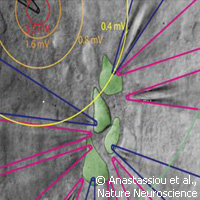Scientists find neurons communicate at a distance with electric fields
Researchers believed neurons in the brain communicated through physical connections known as synapses. However, EU-funded neuroscientists have uncovered strong evidence that neurons also communicate with each other through weak electric fields, a finding that could help us understand how biophysics gives rise to cognition. The study, published in the journal Nature Neuroscience, was funded in part by the EUSYNAPSE ('From molecules to networks: understanding synaptic physiology and pathology in the brain through mouse models') project, which received EUR 8 million under the 'Life sciences, genomics and biotechnology for health' Thematic area of the EU's Sixth Framework Programme (FP6). Lead author Dr Costas Anastassiou, a postdoctoral scholar at the Californian Institute of Technology (Caltech) in the US, and his colleagues explain how the brain is an intricate network of individual nerve cells, or neurons, that use electrical and chemical signals to communicate with one another. Every time an electrical impulse races down the branch of a neuron, a tiny electric field surrounds that cell. A few neurons are like individuals talking to each other and having small conversations. But when they all fire together, it's like the roar of a crowd at a sports game. That 'roar' is the summation of all the tiny electric fields created by organised neural activity in the brain. While it has long been recognised that the brain generates weak electrical fields in addition to the electrical activity of firing nerve cells, these fields were considered epiphenomenon - superfluous side effects. Nothing was known about these weak fields because, in fact, they are usually too weak to measure at the level of individual neurons; their dimensions are measured in millionths of a metre (microns). Therefore, the researchers decided to determine whether these weak fields have any effect on neurons. Experimentally, measuring such weak fields emanating from or affecting a small number of brain cells was no easy task. Extremely small electrodes were used in close proximity to a cluster of rat neurons to look for 'local field potentials', the electric fields generated by neuron activity. The result? They were successful in measuring fields as weak as one millivolt (one millionth of a volt). Commenting on the results, Dr Anastassiou says: 'Because it had been so hard to position that many electrodes within such a small volume of brain tissue, the findings of our research are truly novel. Nobody had been able to attain this level of spatial and temporal resolution.' What they found was surprising. 'We observed that fields as weak as one millivolt per millimetre robustly alter the firing of individual neurons, and increase the so-called "spike-field coherence" - the synchronicity with which neurons fire with relationship to the field,' he says. During the violent seizures of epilepsy, for example,, portions of the brain generate very strong electrics fields - of the order of 100 millivolts per millimetre. However, this study showed is that even much weaker field energy - when directed at a responsive area of neurons - creates what researchers call ephaptic coupling. This energy field 'connection' could be another mode of coordination within the brain - one different from the usual neuron-synapse channels. Dr Anastassiou suggests that 'increased spike-field coherency may substantially enhance the amount of information transmitted between neurons as well as increase its reliability.' This study joins the research on the trail of how 'thinking' depends on the coordinated activity in different brain regions. Many neuroscientists believe that the relatively slow and almost infinitely intertwined activity of neurons and synapses does not add up to the speed and efficiency of thought. 'I firmly believe that understanding the origin and functionality of endogenous brain fields will lead to several revelations regarding information processing at the circuit level, which, in my opinion, is the level at which perceptions and concepts arise,' Dr Anastassiou says. 'This, in turn, will lead us to address how biophysics gives rise to cognition in a mechanistic manner - and that, I think, is the holy grail of neuroscience.'For more information, please visit: California Institute of Technology (Caltech):http://www.caltech.edu/Nature Neuroscience: http://www.nature.com/neuro/index.htmlEUSYNAPSE:http://www.eusynapse.mpg.de/index.html
Countries
United States



